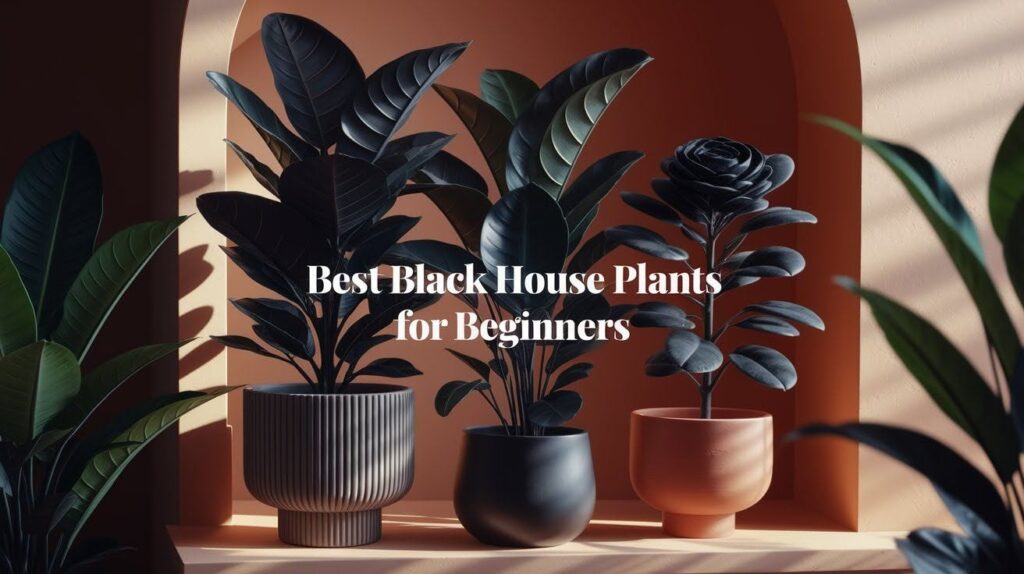I’ll never forget the first time I spotted a Black Pearl ornamental pepper at my local nursery – its dark, almost midnight foliage stopped me in my tracks.
After years of filling my home with the usual green varieties, I was completely captivated by how these dramatic specimens could transform an entire room’s atmosphere. Black houseplants possess an undeniable sophistication that sets them apart from traditional greenery.
Their rich, deep tones create striking contrasts against light walls and furniture, instantly becoming conversation starters when guests visit. What started as curiosity about one unusual plant quickly grew into a passionate collection.
These distinctive varieties don’t just fill empty corners they serve as living art pieces that bring an unexpected boldness to any space, proving that sometimes the most unconventional choices make the most memorable impact.
List of 43 Best Black House Plants for Beginners
A comprehensive collection of dark-foliaged plants perfect for new plant owners, featuring easy-care varieties that thrive indoors with minimal attention.
Low-Maintenance Varieties
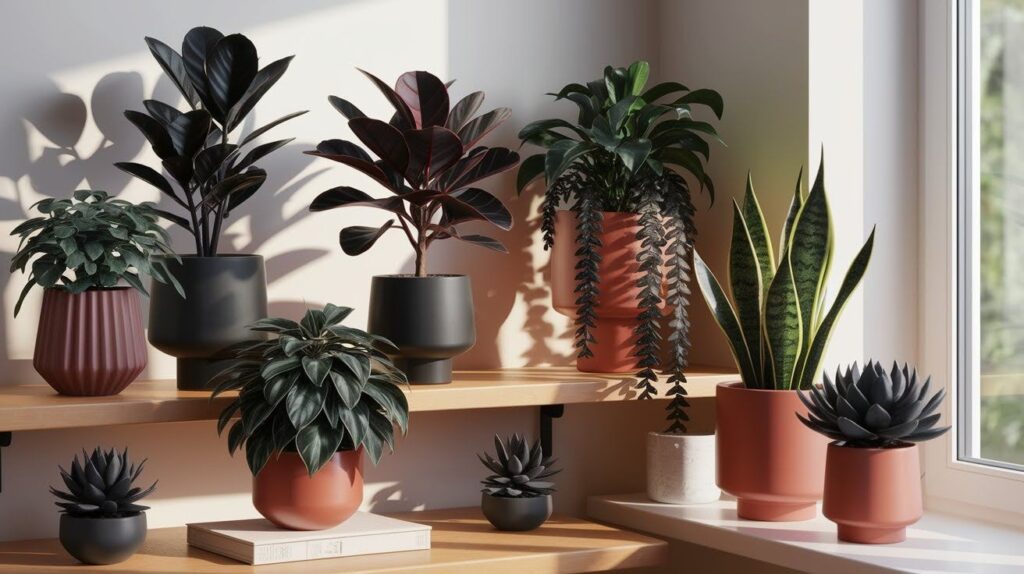
1. ZZ Plant ‘Raven’ (Zamioculcas zamiifolia ‘Raven’)
My most reliable plant friend sits in my living room corner, glossy black stems reaching upward like sculptural art. I water it maybe once a month, and it just keeps growing. Perfect for anyone who thinks they have a “black thumb.”
2. Ficus elastica ‘Burgundy’
This rubber plant variety has survived three years of my inconsistent care with its deep wine-colored leaves that appear nearly black. It bounces back from dry spells and low light like nothing happened.
3. Scindapsus ‘Dark Form’ (Scindapsus pictus ‘Black Satin’)
The velvety texture of these trailing leaves never gets old. Mine cascades from a high shelf, requiring water only when I remember to check – usually every two weeks. It’s practically indestructible.
4. Peperomia metallica
This compact beauty brings metallic shimmer to my desk without demanding daily attention. Its thick, succulent-like leaves store water efficiently, forgiving my irregular watering schedule.
5. Snake Plant ‘Black Gold’ (Sansevieria trifascieta)
Standing tall in my bedroom, this variety combines the classic snake plant’s toughness with dramatic dark edges. I water it monthly at most – sometimes I forget for longer, and it doesn’t mind.
6. Haworthia ‘Black Prince’
My windowsill succulent forms tight rosettes of dark, pointed leaves. Weeks can pass between waterings, making it ideal for busy lifestyles.
7. Echeveria ‘Black Prince’
Another succulent superstar that thrives on neglect. Its purple-black rosettes add drama to my plant shelf while requiring minimal intervention from me.
Compact Plants for Small Spaces
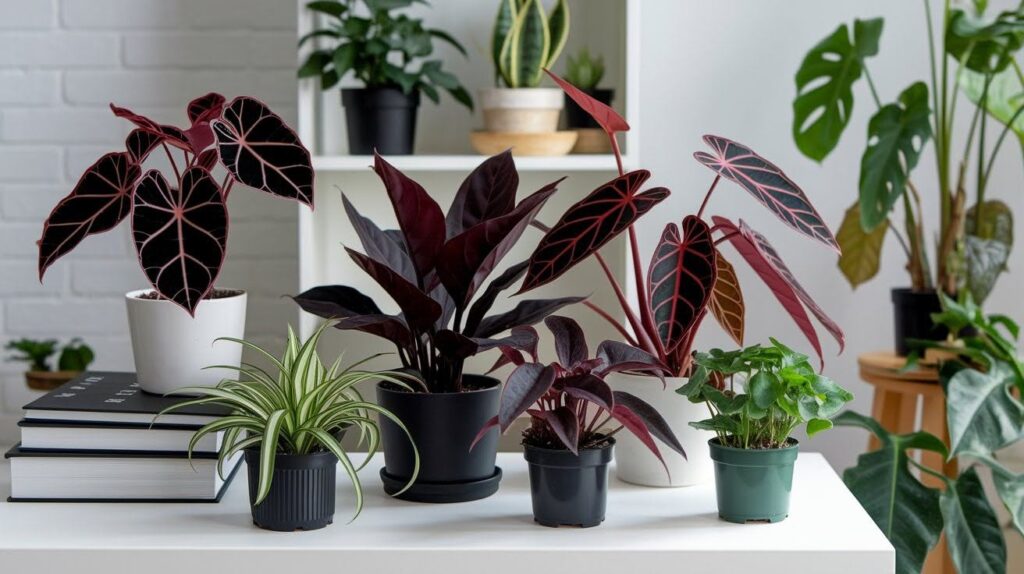
8. Alocasia ‘Black Velvet’ (Alocasia reginula)
This palm-sized gem sits on my nightstand, its heart-shaped leaves feeling exactly like velvet to the touch. The white veins against deep black create an almost magical contrast that never fails to impress visitors in my small bedroom.
Despite its exotic appearance, it stays perfectly contained in a 4-inch pot, making it ideal for tight spaces.
9. Philodendron ‘Black Cardinal’
My desk companion for three years running, this compact beauty stays perfectly sized for small spaces. New leaves emerge bright red before darkening to deep burgundy-black, providing a constant color show during work-from-home days.
It maintains a tidy, upright growth habit that won’t sprawl across your workspace.
10. Syngonium ‘Red Arrow’
Perched on my narrow bookshelf, this arrow-leafed plant shifts from red to nearly black depending on the light. It’s stayed manageable size-wise while adding drama to my limited floor space. The compact growth makes it perfect for shelving units where height is restricted.
11. Anthurium clarinervium
My bathroom counter star thrives in the humidity while taking up minimal real estate. Those prominent white veins against dark foliage create an eye-catching focal point in my tiny space. The leaves stay relatively small compared to other anthurium varieties, making it perfect for countertops.
12. Cryptanthus ‘Black Mystic’ (Earth Star Bromeliad)
This low-growing bromeliad forms a perfect star shape on my coffee table. Its dark, wavy leaves add texture without overwhelming my small living area. The flat rosette growth pattern means it won’t compete for vertical space with taller plants.
13. Peperomia caperata ‘Burgundy Ripple’
The textured, quilted leaves of this compact peperomia bring rich burgundy-black tones to my kitchen windowsill without crowding other plants. It rarely exceeds 6 inches in height, making it perfect for shallow shelves or grouped arrangements.
14. Pilea ‘Dark Mystery’
This petite variety fits perfectly in small pots, its rounded leaves providing deep color accents throughout my apartment’s tight corners and shelves. Its mounding habit creates a neat, contained appearance that won’t outgrow designated spaces.
Tropical Statement Plants
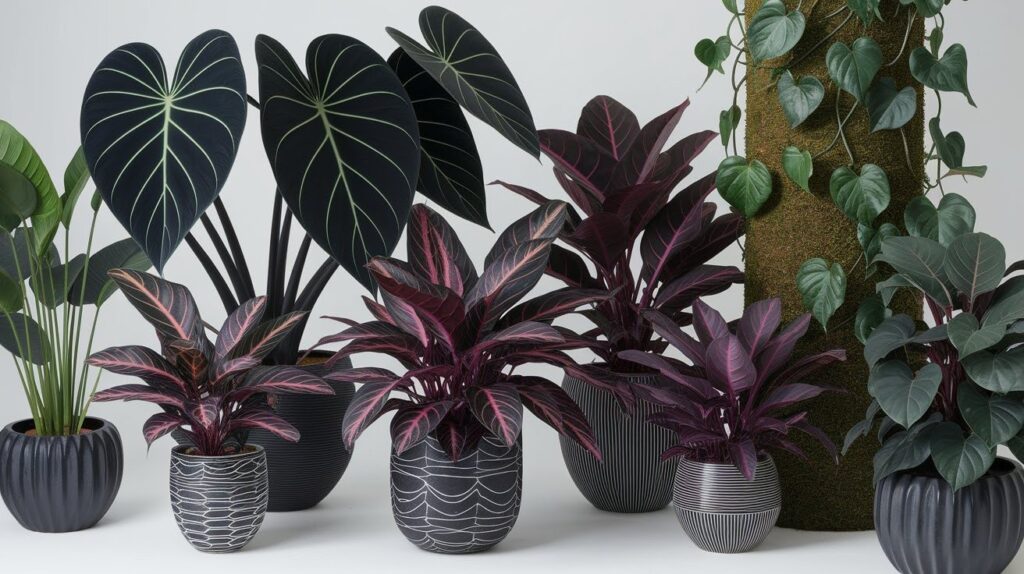
15. Colocasia ‘Black Magic’
This elephant ear variety has become the centerpiece of my living room with its massive, heart-shaped leaves that appear almost jet black in certain lighting.
Watching new leaves unfurl is like witnessing nature’s own magic trick – they emerge tightly coiled before opening into dramatic, velvety surfaces that can reach impressive sizes. The sheer scale of each leaf creates an instant focal point that anchors my entire room design.
16. Aeonium arboreum ‘Zwartkop’ (Black Rose)
My succulent sculpture sits proudly on the patio table, forming perfect rosettes that look like black roses carved from stone. During cooler months, the edges develop a stunning purple tint that makes guests stop mid-conversation to admire it.
The architectural form works beautifully both as a standalone specimen and grouped with other succulents.
17. Alocasia cuprea (Mirror Plant)
The metallic copper-bronze sheen on these leaves creates an almost mirror-like surface that reflects light beautifully throughout my dining room. Each leaf displays different color variations depending on the angle, making it a constantly changing focal point.
The thick, substantial leaves feel almost artificial due to their incredible metallic finish.
18. Philodendron melanochrysum
This climbing beauty has taken over my moss pole with its large, velvety leaves that shimmer with golden undertones. The juvenile leaves start smaller and darker, gradually developing their characteristic size and metallic highlights as they mature.
Watching this transformation happen over months adds an element of anticipation to my plant care routine.
19. Calathea ‘Dottie’
My prayer plant creates nightly entertainment as its leaves fold upward each evening, revealing bright pink undersides against the deep purple-black tops. The intricate patterns and color combinations make it impossible to ignore.
Morning light reveals the leaves opening again, creating a daily rhythm that connects me to natural cycles.
20. Oxalis triangularis ‘Black’ (Purple Shamrock)
These triangular leaves dance throughout the day, opening and closing with the light changes. The deep purple foliage contrasts beautifully with delicate pink flowers that appear seasonally.
The constant movement keeps this plant feeling alive and responsive in ways that static foliage cannot match.
21. Cordyline fruticosa ‘Black Magic’
This tropical stunner brings architectural drama to my corner with its sword-like leaves in deep burgundy-black. As it matures, it develops a tree-like structure that adds vertical interest to any space.
The upright growth habit makes it perfect for corners that need height without spreading width.
Distinct Textured Foliage
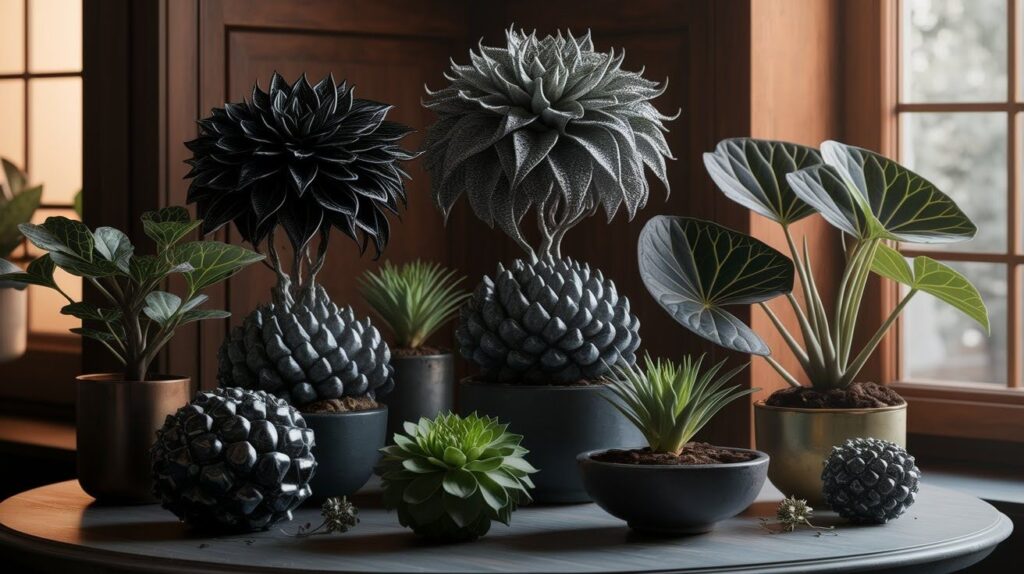
22. Begonia ‘Black Fang’
The metallic shimmer on these leaves creates an almost otherworldly appearance in my bright kitchen window.
Running my fingers across the surface reveals a smooth, waxy texture that contrasts beautifully with the dramatic coloring and jagged leaf edges that give this variety its fierce name.
23. Begonia ‘Jurassic Silver Swirl’
This rex begonia displays intricate silver spirals against deep black backgrounds, creating patterns that look hand-painted by an artist. The velvety texture feels luxurious to touch, and each leaf shows slightly different swirl patterns, making every angle a new discovery.
24. Anthurium ‘Ace of Spades’
True to its name, these spade-shaped leaves feel thick and leathery, with a glossy finish that reflects light like polished leather. The deep black-green surface has subtle ridging that creates interesting shadows and highlights throughout the day.
25. Colocasia esculenta ‘Diamond Head’
These elephant ear leaves combine a matte finish with pronounced veining that creates natural texture patterns. The surface feels substantial yet soft, with a slight fuzziness that makes it incredibly pleasant to touch while admiring its rich purple-black coloration.
26. Alocasia plumbea ‘Nigra’
The thick, rubbery texture of these leaves gives them an almost succulent-like quality despite being a tropical plant. Each leaf displays a subtle metallic sheen that shifts between purple and black depending on the lighting angle.
27. Pilea involucrata ‘Norfolk’
The quilted texture of these small leaves creates fascinating shadow patterns that change throughout the day. The raised veining gives each leaf a three-dimensional quality that adds visual depth to this compact variety.
28. Helleborus niger (Christmas Rose – potted indoors)
When grown in containers, these leathery leaves provide year-round interest with their deeply textured surface and rich green-black coloring. The substantial feel of each leaf speaks to this plant’s hardy nature and long-lasting beauty.
Flowering Black Beauties
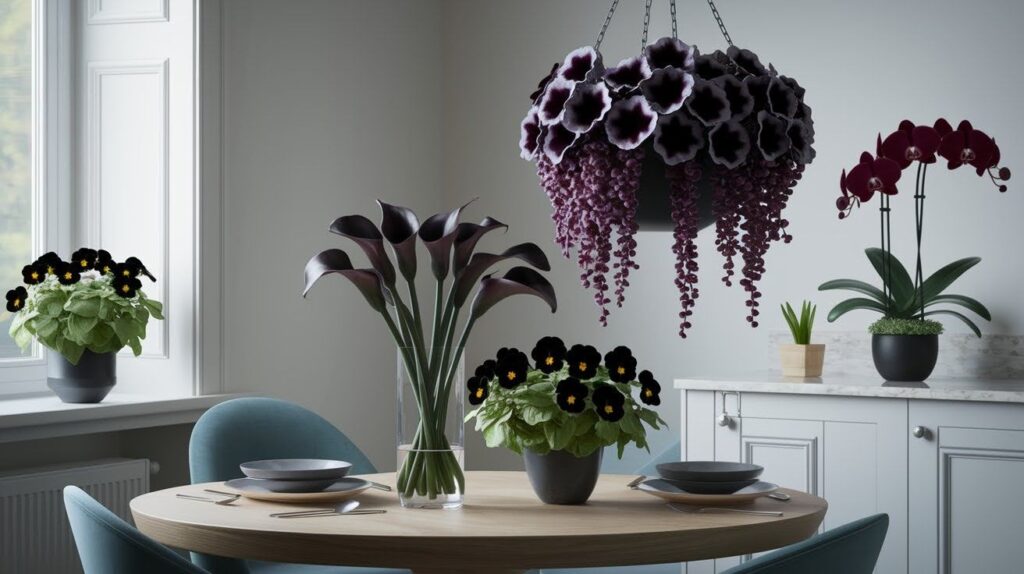
29. Black Calla Lily (Zantedeschia ‘Black Star’)
My dining table centerpiece produces elegant trumpet-shaped blooms in deep burgundy-black that look almost velvet against the light. The sleek, architectural flowers last for weeks, creating a sophisticated focal point that never fails to spark conversation during dinner parties.
30. Petunia ‘Black Velvet’ (indoor potted)
These trailing beauties cascade from my hanging basket near the bright living room window, producing countless small flowers that appear nearly black in certain light.
The continuous blooming cycle means I get fresh flowers almost year-round with proper care and adequate sunlight.
31. Iris ‘Before the Storm’ (potted dwarf variety)
This compact iris variety brings classic flower form in dramatic dark purple-black petals that seem to absorb light. Growing it in a container allows me to move it to different spots throughout my home, creating seasonal displays on tables and plant stands.
32. Viola ‘Molly Sanderson’ (indoor container)
These tiny pansy-like faces peer up from my kitchen windowsill with their deep black petals and bright yellow centers. The contrast is striking, and the delicate flowers keep appearing throughout the growing season with regular deadheading.
33. Black Pansy (Viola x wittrockiana)
My potted pansies create cheerful displays despite their dark coloring, with faces that seem to watch from my sunny breakfast nook. These cool-weather lovers provide months of blooms when grown in containers that can be moved to ideal temperatures.
34. Orchid ‘Fredclarkeara After Dark’
This exotic beauty sits on my bathroom counter, producing deep burgundy-black orchid blooms that last for months. The intricate flower structure and rich coloring make it feel like having a piece of luxury jewelry in plant form.
35. Tulip ‘Queen of Night’ (forced indoors)
My spring container display features these sophisticated tulips with petals so dark they appear almost black in low light. Forcing bulbs indoors allows me to enjoy these dramatic blooms weeks before outdoor varieties would appear.
Succulents & Cacti with Dark Tones
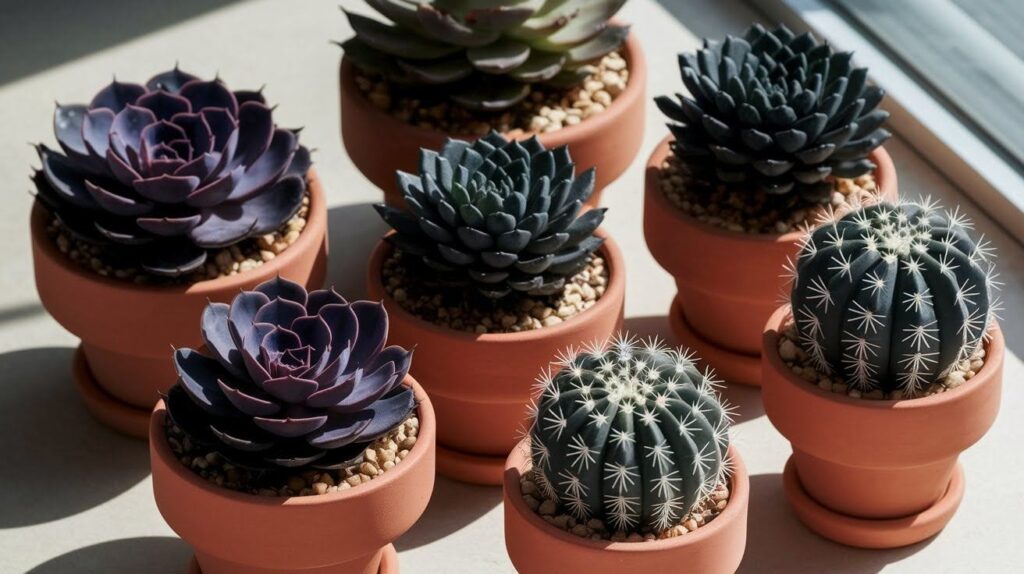
36. Echeveria ‘Black Knight’
This rosette-forming beauty sits on my brightest windowsill, its deep purple-black leaves forming perfect geometric patterns.
During stress periods (which I’ve learned is actually good for succulents), the edges develop an even deeper burgundy color that makes the entire plant look almost gothic. The thick, fleshy leaves store water efficiently, forgiving my irregular watering habits.
37. Aeonium ‘Voodoo’
My dinner plate-sized specimen creates an incredible focal point with its flat rosettes of nearly black leaves.
The dramatic coloring intensifies during cooler months, and watching new growth emerge from the center feels like witnessing slow-motion fireworks. This variety stays compact while making maximum visual impact.
38. Sinocrassula yunnanensis (Chinese Jade)
This tiny powerhouse forms dense clusters of small, dark rosettes that look like miniature black roses covering the soil surface.
The spreading habit creates living carpets in my succulent arrangements, and the deep coloring provides perfect contrast against lighter varieties. Each individual rosette stays small, but the collective effect is stunning.
39. Graptopetalum ‘Black Pearl’
The thick, pointed leaves of this succulent create star-shaped rosettes with an almost metallic finish. Mine sits in a hanging planter where the trailing growth habit shows off its unique coloring from multiple angles.
The pearl-like appearance of each leaf gives this plant an almost jewelry-quality aesthetic.
40. Black Ball Cactus (Gymnocalycium mihanovichii var. friedrichii)
This compact cactus brings sculptural interest to my desk with its perfectly spherical form and deep burgundy-black coloring.
The geometric spine patterns create fascinating shadow play throughout the day, and its small size makes it perfect for tight spaces where larger plants won’t fit.
Rare Collector’s Picks
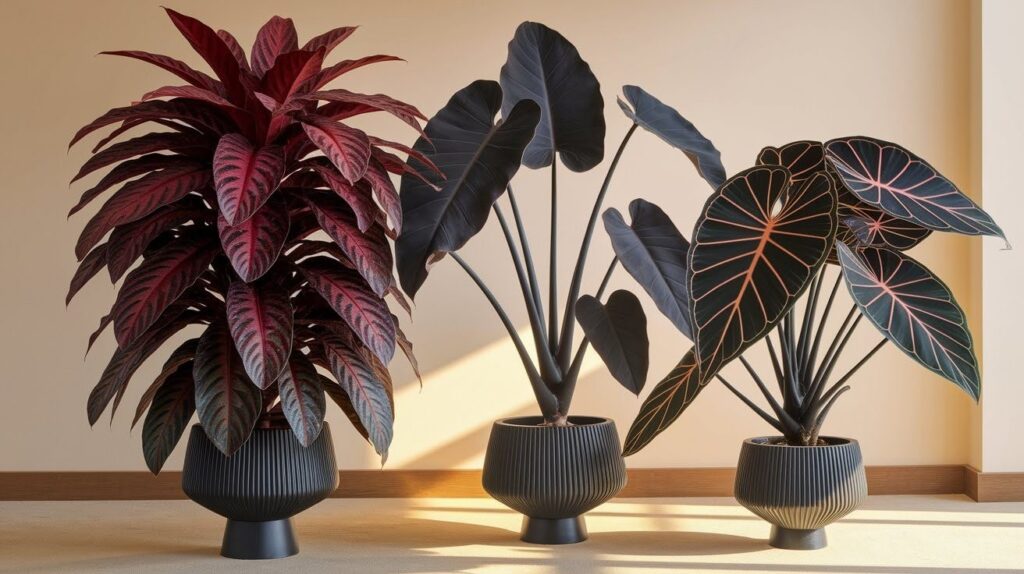
41. Philodendron ‘Dark Lord’
After searching for over a year, I finally found this incredible variety through a specialized plant dealer. The massive leaves emerge deep burgundy-red before maturing to an almost black color with metallic undertones that shift throughout the day.
What makes this plant truly special is the combination of size and color intensity – mature leaves can reach impressive dimensions while maintaining that rich, dark coloring that most varieties lose as they age.
The climbing habit means it continues to produce larger, more dramatic leaves as it matures up its support structure.
42. Colocasia ‘Midnight’
This elephant ear variety pushes the boundaries of how dark foliage can get, with leaves that appear to absorb light rather than reflect it. Finding this cultivar required connecting with specialty growers, but the wait was worth every day.
The velvety texture combined with the near-black coloring creates an almost surreal appearance that makes guests question whether it’s real.
Each new leaf unfurls with anticipation, revealing increasingly dramatic coloring as the plant settles into optimal growing conditions.
43. Alocasia ‘Regal Shields’
The crown jewel of my alocasia collection displays thick, shield-shaped leaves with prominent white veining against deep black-green surfaces.
This hybrid variety combines the best traits of its parent plants, creating leaves that feel substantial and leathery while maintaining incredible visual impact.
The rarity comes from its slow propagation rate and specific growing requirements, making each specimen precious to collectors who appreciate its unique combination of texture, pattern, and coloring.
Basic Care Tips for Black Houseplants
Light Requirements
- Most dark-foliaged plants prefer bright, indirect light rather than direct sunlight
- Place them near windows with sheer curtains or a few feet back from bright openings
Watering and Soil Drainage
- Most dark varieties prefer to dry out slightly between waterings
- Stick your finger about an inch into soil, if dry, it’s time to water
Humidity and Temperature
- Tropical dark plants thrive in bathroom humidity or near humidifiers
- Group plants together to create beneficial micro-climates
- Maintain temperatures between 65-80°F for most varieties
Conclusion
After years of growing these dramatic specimens, I can confidently say that black houseplants offer the perfect combination of visual impact and beginner-friendly care.
They’ve taught me that you don’t need complicated routines to achieve stunning results – just consistent basics and a little patience. Starting with forgiving varieties like ZZ Plant ‘Raven’ or Snake Plant ‘Black Gold’ builds confidence while adding instant sophistication to any space.
These plants have transformed my home from ordinary to extraordinary, proving that sometimes the most dramatic choices are also the most practical. Trust me, once you experience the joy of watching dark foliage thrive under your care, you’ll wonder why you waited so long to try them.
Frequently Asked Questions
Are black houseplants harder to care for than regular green plants?
Not at all! Most black houseplants are actually quite forgiving and many are specifically recommended for beginners.
Why do some plants have black or dark-colored leaves?
Plants develop dark foliage due to high concentrations of anthocyanins that help protect them from environmental stress.
Do black plants need different lighting than green plants?
Black plants generally prefer the same bright, indirect light as most houseplants, with some tolerating lower light even better.
How often should I water my black houseplants?
Most prefer to dry out slightly between waterings – check if the top inch of soil feels dry first.
Which black houseplant is best for absolute beginners?
ZZ Plant ‘Raven’ is the best starter option because it tolerates neglect, low light, and irregular watering schedules.

